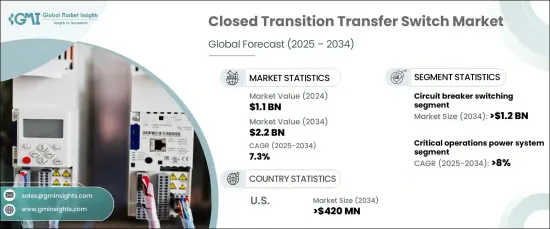
세계의 무정전 절체 스위치(CTTS) 시장 규모는 2024년에 11억 달러로 평가되었으며, 2025년부터 2034년까지 연평균 성장률(CAGR) 7.3%로 확대될 것으로 예측됩니다.
이 시장은 미션 크리티컬 환경에서 안정적인 전력 전송 솔루션에 대한 수요 증가로 인해 꾸준히 성장하고 있습니다. 의료, 데이터 센터 및 제조와 같이 운영을 위해 지속적이고 중단 없는 전력이 필요한 분야에서는 장비 고장을 방지하고 운영 효율성을 유지하기 위해 이러한 스위치를 점점 더 많이 채택하고 있습니다.

전력망 현대화에 초점을 맞춘 정부 전략이 시장 확대에 기여하고 있습니다. 특히 재생 에너지, 하이브리드 시스템 및 마이크로그리드의 통합이 증가함에 따라 주목할 만한 성장세를 보이고 있습니다. 이러한 기술이 더욱 널리 보급됨에 따라 일관된 전력 흐름을 유지하기 위해서는 안정적인 전력 전환 시스템의 필요성이 대두되고 있습니다. 또한, 더욱 엄격해진 에너지 효율 표준과 자동화 기술의 사용 증가도 시장 성장을 견인하는 데 중요한 역할을 하고 있습니다.
| 시장 범위 | |
|---|---|
| 시작 연도 | 2024년 |
| 예측 연도 | 2025-2034년 |
| 시작 금액 | 11억 달러 |
| 예측 금액 | 22억 달러 |
| CAGR | 7.3% |
회로 차단기 메커니즘을 사용하는 시장 부문은 2034년까지 12억 달러 이상이 될 것으로 예상됩니다. 이러한 성장은 신뢰성이 중요한 산업에서 무중단 전력에 대한 긴급한 필요성에 의해 주도되고 있습니다. 회로 차단기 기반 절체 스위치는 이러한 시나리오에 이상적이며, 가동 중단 시간을 최소화하고 민감한 장비를 보호하는 원활한 전력 전환을 제공합니다. 이러한 수요는 향상된 고장 보호와 안정적인 전력 흐름이 필요한 재생 에너지원의 확대와 스마트 그리드 기술의 발전으로 인해 더욱 촉진되고 있습니다.
중요 작업의 무정전 절체 스위치 시장은 2034년까지 연평균 성장률이 8%를 넘어설 것으로 예상되는 등 빠르게 성장할 것으로 전망됩니다. 이러한 수요 급증은 지속적인 전력 공급에 크게 의존하는 산업과 관련이 있으며, 사소한 중단도 심각한 결과를 초래할 수 있습니다. 따라서 기업들은 정전으로부터 운영을 보호하기 위해 무정전 전원 공급 장치(UPS) 및 백업 발전기와 같은 백업 전력 솔루션에 더 많은 투자를 하고 있습니다. 자동화, 스마트 그리드, 재생 에너지의 사용 증가와 에너지 효율 표준 충족에 대한 관심이 이러한 성장을 더욱 촉진하고 있습니다.
미국의 무정전 절체 스위치 시장은 2034년까지 4억 2,000만 달러를 넘어설 것으로 예상됩니다. 이러한 성장은 의료, 제조, 데이터 관리와 같은 분야에서 안정적인 전력 전송 시스템에 대한 수요가 증가함에 따라 주도되고 있습니다. 재생 에너지와 스마트 그리드 기술의 도입으로 이러한 시스템의 필요성이 가속화되고 있습니다. 정전 및 장비 보호에 대한 우려가 증가함에 따라 폐쇄형 전환 스위치 시장은 계속해서 성장하고 있으며, 업계에 원활한 전력 전환을 위한 신뢰할 수 있는 솔루션을 제공하고 있습니다.
The Global Closed Transition Transfer Switch Market was valued at USD 1.1 billion in 2024 and is projected to expand at a CAGR of 7.3% from 2025 to 2034. The market is seeing steady growth due to the rising demand for reliable power transfer solutions in mission-critical environments. Sectors that require continuous, uninterrupted power for their operations, such as healthcare, data centers, and manufacturing, are increasingly adopting these switches to prevent equipment failures and maintain operational efficiency.

Government initiatives focused on modernizing power grids are contributing to market expansion. A notable boost comes from the growing integration of renewable energy, hybrid systems, and microgrids. As these technologies become more widespread, the need for reliable power transition systems becomes essential to maintaining consistent power flow. Additionally, stricter energy efficiency standards and the increasing use of automation technologies are playing a key role in driving market growth.
| Market Scope | |
|---|---|
| Start Year | 2024 |
| Forecast Year | 2025-2034 |
| Start Value | $1.1 Billion |
| Forecast Value | $2.2 Billion |
| CAGR | 7.3% |
The market segment using circuit breaker mechanisms is expected to exceed USD 1.2 billion by 2034. This growth is driven by the pressing need for uninterrupted power in industries where reliability is a critical factor. Circuit breaker-based transfer switches are ideal in these scenarios, offering seamless power transitions that minimize downtime and protect sensitive equipment. This demand is further fueled by the expansion of renewable energy sources and advancements in smart grid technologies, which require enhanced fault protection and stable power flow.
The market for closed transition transfer switches in critical operations is set to grow rapidly, with a projected CAGR exceeding 8% through 2034. This surge in demand is linked to industries that rely heavily on a continuous power supply, where even minor interruptions can have significant consequences. Consequently, businesses are investing more in backup power solutions, such as uninterruptible power supplies (UPS) and backup generators, to safeguard their operations against power outages. The increased use of automation, smart grids, and renewable energy, along with a focus on meeting energy efficiency standards, further drives this growth.
In the U.S., the market for closed transition transfer switches is expected to surpass USD 420 million by 2034. This growth is driven by the increasing demand for reliable power transfer systems in sectors like healthcare, manufacturing, and data management. The adoption of renewable energy and smart grid technologies is accelerating the need for these systems. As power outages and equipment protection concerns rise, the market for closed transition transfer switches continues to thrive, providing industries with a dependable solution for seamless power transitions.